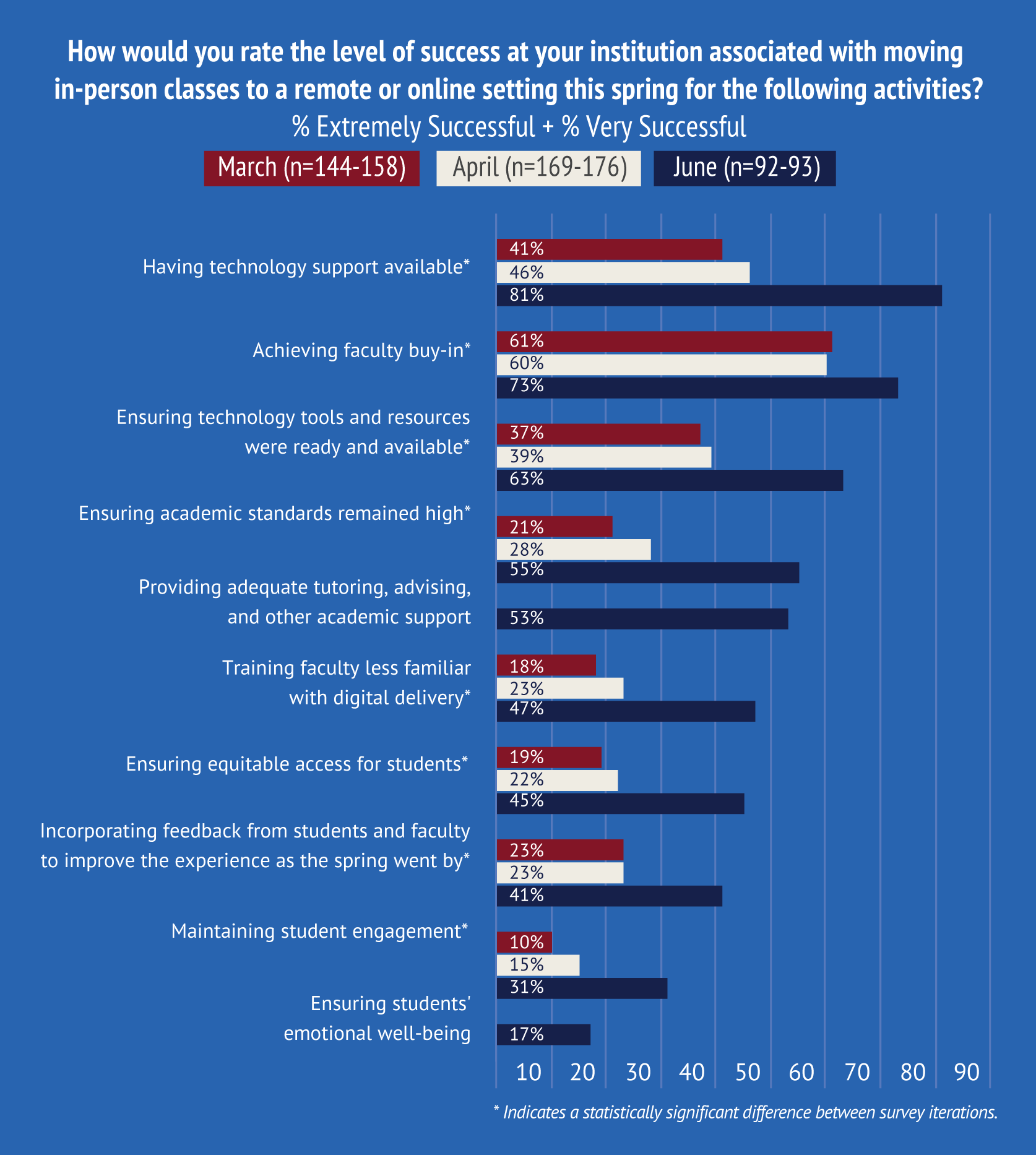Free Download
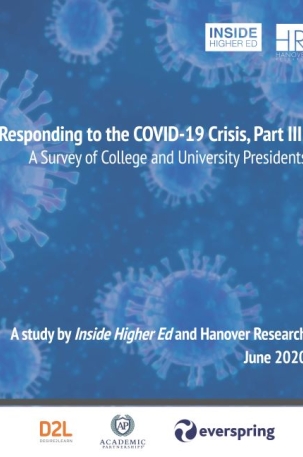
As Inside Higher Ed has surveyed college and university presidents several times over the course of this COVID-19-dominated spring, some things have remained constant. The leaders’ sometimes conflicting concerns about student and employee health and institutional finances. Uncertainty about if and when they will reopen campuses and resume sports programs. Awareness that difficult financial decisions, driven by the recession, are ahead.
But certain issues have taken on greater magnitude as a fall like no other nears.
A new iteration of the survey of campus leaders by Inside Higher Ed and Hanover Research, published today, finds presidents likelier than they were two months ago to expect their institutions to reduce their portfolio of academic programs (55 percent versus 41 percent in April).
Majorities of presidents remain confident in their colleges’ ability to educate students safely and well, whether they’re on campuses or off this fall. But far fewer believe their institutions can ensure the safety of vulnerable people in their surrounding communities (39 percent) or ensure that students will behave responsibly when they’re not being watched (29 percent).
And nearly three-quarters of presidents (72 percent) are either very or somewhat concerned about a "perceived decrease in the value of higher education" because of COVID-19, up sharply from 60 percent of respondents in April and 48 percent in March.
That worry seems to flow from college leaders’ sense that what they are capable of delivering in the COVID-19 era will reinforce already existing doubts about quality and value: growing numbers of campus leaders, about half, said they worry about student demands for room and board and tuition reimbursement; more than two-thirds fear a decline in alumni/donor giving rates; and 39 percent, up from 29 percent in April, said they anticipate "perceived negativity" from campus constituents about their institution’s response to COVID-19.
About the Survey
"Responding to the COVID-19 Crisis, Part III: A Survey of College and University Presidents" is available, free, for download here.
The survey of 97 college leaders was conducted by Hanover Research on behalf of Inside Higher Ed.
Inside Higher Ed’s editors will lead a webcast discussion of the survey’s results on Wednesday, July 1, 2 p.m. Eastern. Please sign up here.
The survey was made possible by advertising support from Academic Partnerships, D2L and Everspring.
The survey’s results suggest that campus leaders are approaching the fall and beyond with deep uncertainty and more than a little anxiety, but that many see opportunity as well.
Asked to assess how their institution will respond to the COVID-19 pandemic and the ensuring recession, a full half, 50 percent, said they hoped it would make "difficult but transformative changes" to "better position itself for long-term sustainability, while another 35 percent said their college or university should "focus more on what it does best" so it can "invest and grow in those areas once the recession ends. About one in 10 presidents said they believe the institution could "ride out the current difficulties" and return to normal within 12 to 18 months, and just 3 percent said their institution should tighten its focus and emerge "smaller but better."
Taken together, the survey results find college leaders balancing health and financial issues and concerns, a yin and yang that underlies just about every decision facing they face right now, as they weigh whether to open their campuses fully, partially or not at all.
Inside Higher Ed asked a fairly consistent set of questions in its surveys in March, April and June, which allows some analysis of how presidents’ views have changed over the four months since the pandemic descended on higher education and shuttered most campuses. (Significantly fewer presidents responded to the June iteration of the survey, for reasons that are not clear.)
Presidents’ top concerns have remained largely the same over that time, focused on a mix of student and employee health and institutional financial woes.
While the pandemic’s disproportionate impact on disadvantaged students and the mental health of students remain near the very top of issues on which presidents relayed their "current level of concern," they’ve been displaced in the most recent survey by presidents’ worries about unbudgeted financial costs related to COVID-19, about which 96 percent of leaders said they were either very or somewhat concerned, up from 84 percent in April.
Concerns about the physical health of students and employees is rising again as campuses start or prepare to reopen. In March, as the pandemic bore down, more than eight in 10 presidents expressed worries about their constituents’ physical health. That eased in April, but it has climbed again in June.
Presidents expressed less (if still meaningful) concern about their institutions’ forced shift to remote learning, and that same sentiment emerged when respondents were asked to assess how that shift went.
Two-thirds or more of respondents said their institutions had been extremely or very successful at having technology support available, achieving faculty buy-in and ensuring the availability of technology tools and resources, and more than half gave themselves high marks at ensuring high academic standards and providing adequate tutoring and other academic support. On most of those points, presidents’ assessment improved as the term went on.
In other areas the presidents acknowledged room for improvement, sometimes significant.
Under half of college chiefs said they had been extremely or very successful at training faculty members less familiar with digital delivery (47 percent), ensuring equitable access for students (45 percent) and incorporating feedback from students and instructors to improve the experience as spring went on.
Their self-reviews were even worse when it came to maintaining student engagement and ensuring students’ emotional well-being. More presidents (27 percent) said their institutions were slightly (25 percent) or not at all successful at ensuring student well-being than said they were extremely or very successful (17 percent), while just 31 percent gave their colleges top marks on student engagement. Fifty-three percent said they were moderately successful on that front.
Tamara Hiler, director of education at Third Way, a center-left think tank, said that the group’s research into students’ perceptions of their education last spring found that students "have been very forgiving of institutions, understanding that much of what has happened has been outside of their control." But she said presidents’ perceptions that that "they were extremely or very successful in maintaining high standards in their move to online courses feels like it may be setting institutions up on a collision course with students who did not seem to indicate that this was the case," especially if the "benefit of the doubt" colleges received wanes this fall.
It’s All About Fall
College officials are focused intensely on their plans for the fall term right now, and the survey offers insights into presidents’ thinking about how it will unfold.
One question asks them when they think they will reverse the various steps they took during the spring in response to COVID-19 and, consistent with the pronouncements they have made in recent weeks, most campus leaders seem intent on reopening their physical campuses this fall.
Two-thirds of presidents say they will undo the decision to move the majority of in-person courses online by summer (20 percent) or fall (48 percent), while 8 percent say they plan to do so by January and 20 percent said they had an "uncertain timeline." At least three-quarters said they would reopen campus dining and residence halls by fall, but only 59 percent expected to restart athletics programs by fall, with 30 percent envisioning an uncertain timeline.
Regarding the campus workplace, about seven in 10 said they would reopen academic and administrative buildings by fall, but fewer, 52 percent, said they expected to reverse remote-work policies by then. Nearly a quarter (23 percent) cited an uncertain timeline for reversing those policies, and 13 percent said they would never reverse those policies.
Roughly half of presidents said their institutions had taken steps this spring to curtail their workforces or their budgets for employees, through furloughs or layoffs or cuts in salaries or benefits. Some of those cuts may end up being permanent: for example, 39 percent of campus leaders who said they had reduced their workforce said they had an uncertain timeline for reversing those cuts, and 25 percent said they never expected to do so. Similarly, 29 percent of those who had reduced benefits said they did not ever anticipate undoing those reductions.
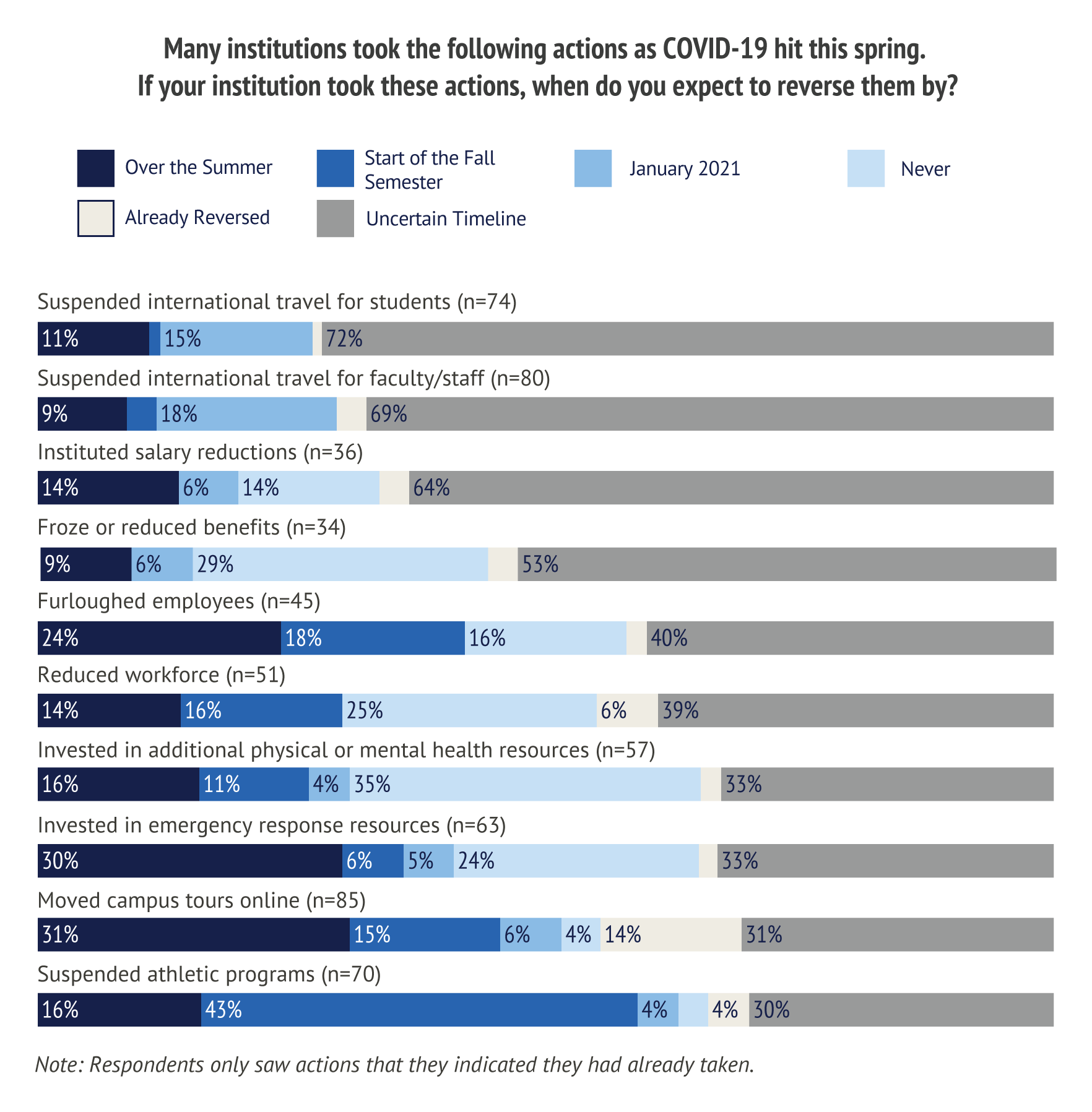 | 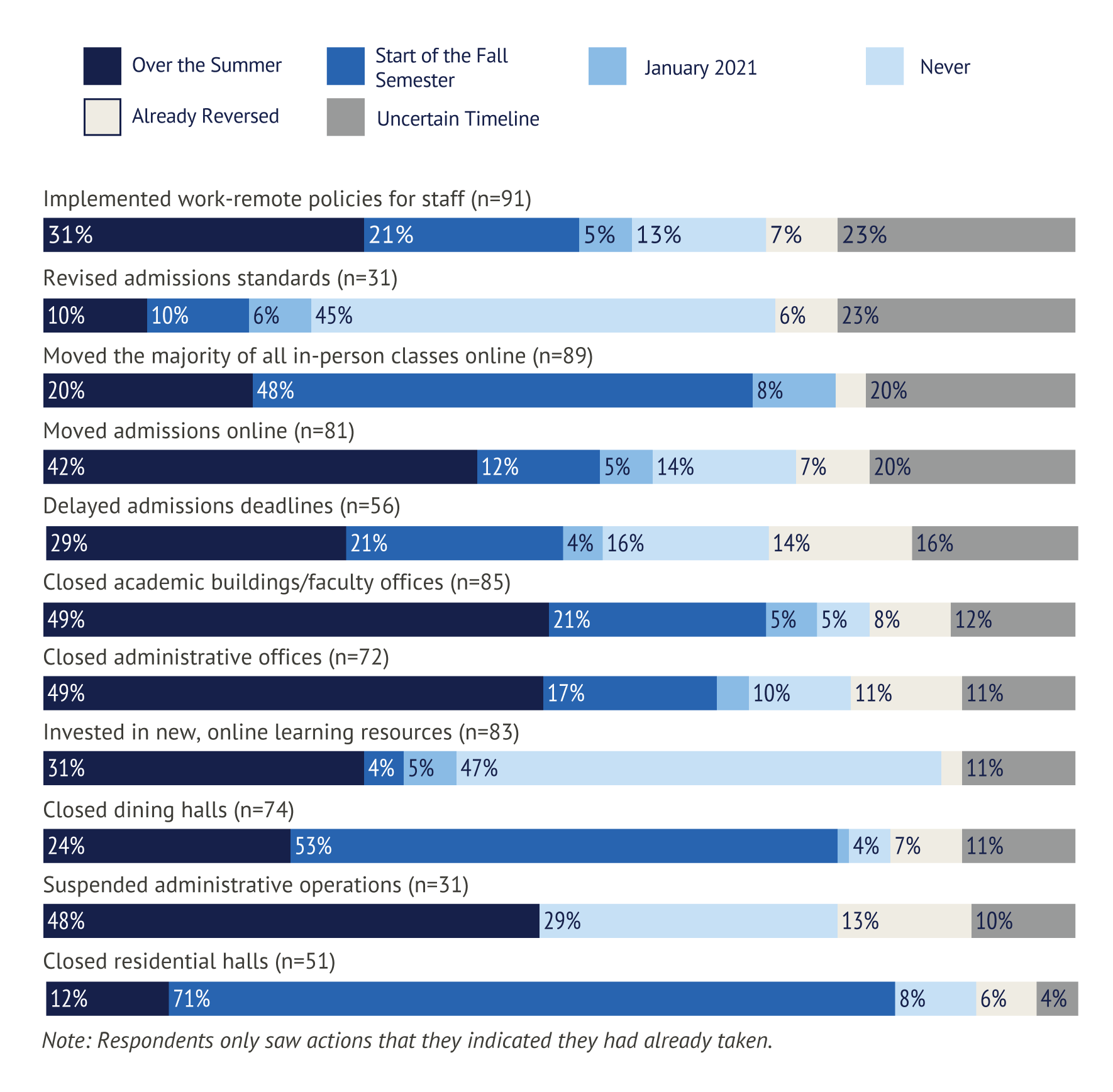 |
The survey asked presidents to directly assess their confidence about various elements of their institutions’ approach to the fall.
When it comes to bringing students back to campus, two-thirds of presidents said they were extremely or very confident they could feed returning students safely and give them a "flexible, high-quality learning experience." Slightly more than half (53 percent) expressed confidence that they could house students safely, and roughly similar numbers said they could ensure the safety of faculty members (56 percent) and staff members (54 percent). Most of the rest said they were moderately confident; fewer than 10 percent said they were only slightly or not at all confident.
Fewer said they believed their institutions could ensure the safety of "vulnerable people in the community surrounding our campus" (39 percent), and even fewer seemed confident they could protect students from themselves. Only 29 percent said they were extremely or very confident that their institution "will help students behave responsibly (e.g., social distancing) on their own," and 30 percent said they were either slightly or not at all confident.
Presidents expressed a similarly mixed assessment about how the fall might unfold for those who remain virtual. Nearly six in 10 leaders expressed confidence that their college or university can "give students who remain remote a high-quality learning experience" (57 percent) and provide high-quality student support and services (55 percent). But only a third, 34 percent, are confident they can make students who remain remote "feel virtually connected."
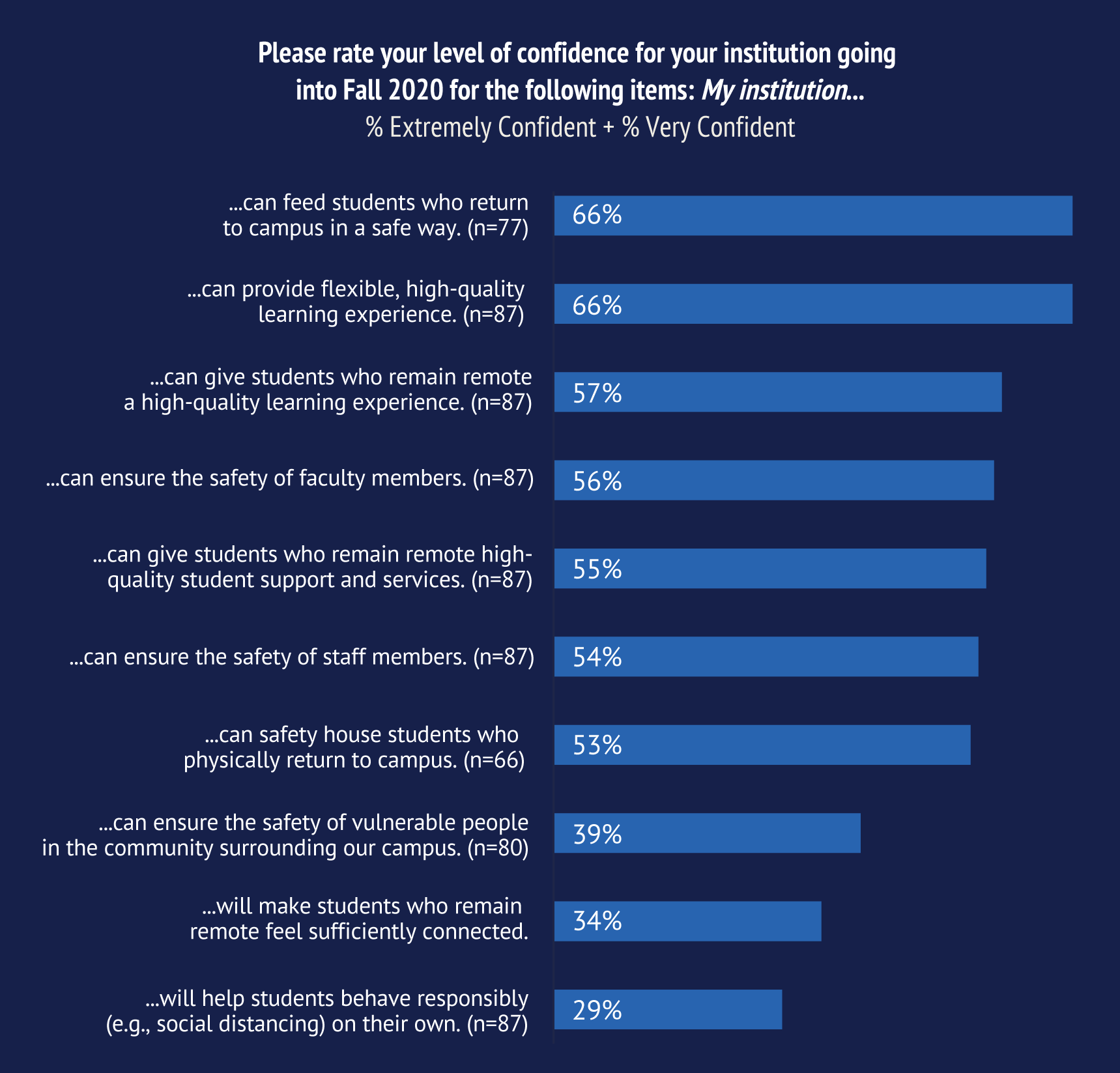
Those answers capture the conundrum that many college leaders are facing as they make decisions about the fall now, says Samantha Fisher, managing director of the education practice at Accenture, a consulting firm. "One of the things most on students’ minds when making a decision of where to enroll -- student engagement -- is something that [college presidents] don’t believe they have done well in spring -- less than one-third feel they were successful at maintaining student engagement," Fisher said.
"The dominant solution seems to be to get students physically back on campus, but the restrictions needed for fall mean that the experience will not be what it once was. If they want to maintain enrollment, institutions will need to grapple with how to foster virtual student engagement and connectedness -- whether for their on-campus-but-restricted students or for a more equitable experience for their remote students."
Worries Ahead
While much of what’s in store remains uncertain, presidents seem relatively sure that they will face financial difficulties. Asked to rate their level of concern about a list of potential issues, 91 percent of presidents said they were very (50 percent) or somewhat concerned about declines in future student enrollment, and 88 percent expressed concern about overall financial stability (31 percent said they were very concerned). Eighty-one percent expressed concern about their ability to afford to employ faculty and staff members.
Presidents remain very concerned about the current situation’s inequitable impact on underrepresented students, who are likeliest to have their educational plans derailed by a combination of job or income loss, increased family responsibilities or health risks related to COVID-19, or diminished engagement with their college or university.
And rising on the list of presidents’ worries is a perceived decrease in the value of higher education, with nearly three-quarters of campus leaders saying they are very or somewhat concerned about that, up from just half in March.
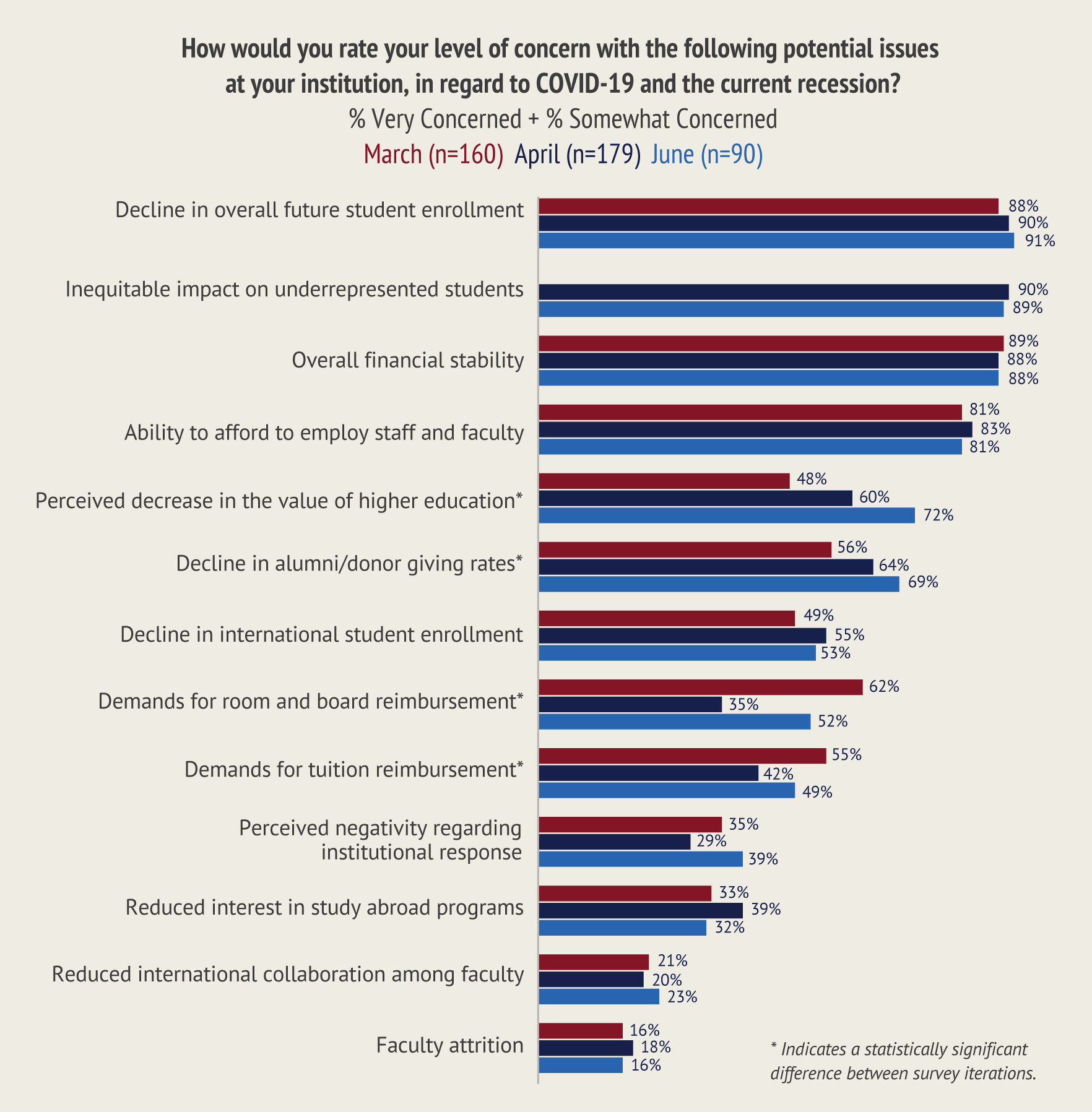
Denny Meadows, who consults with colleges on strategy with SilverFern Advisory, noted that public doubts of the value of a college degree have been "building for many years," as college prices and debt levels rise and wages stagnate. "It seems to have taken a pandemic for some leaders to take them seriously," she said, describing that recognition as a potential "silver lining" of the current situation.
She and others cited as evidence of that recognition presidents’ answers to a new question about how their institution will respond to the pandemic and recession, with a full half of campus leaders saying they believed their college or university should "use this period to make difficult but transformative changes in its core structure and operations to better position itself for long-term sustainability." About a third of presidents said their institution should focus more on its strengths so it can emerge from the recession in a position to grow. Smaller numbers of presidents said they hoped to ride out the recession and return to normal or shrink.
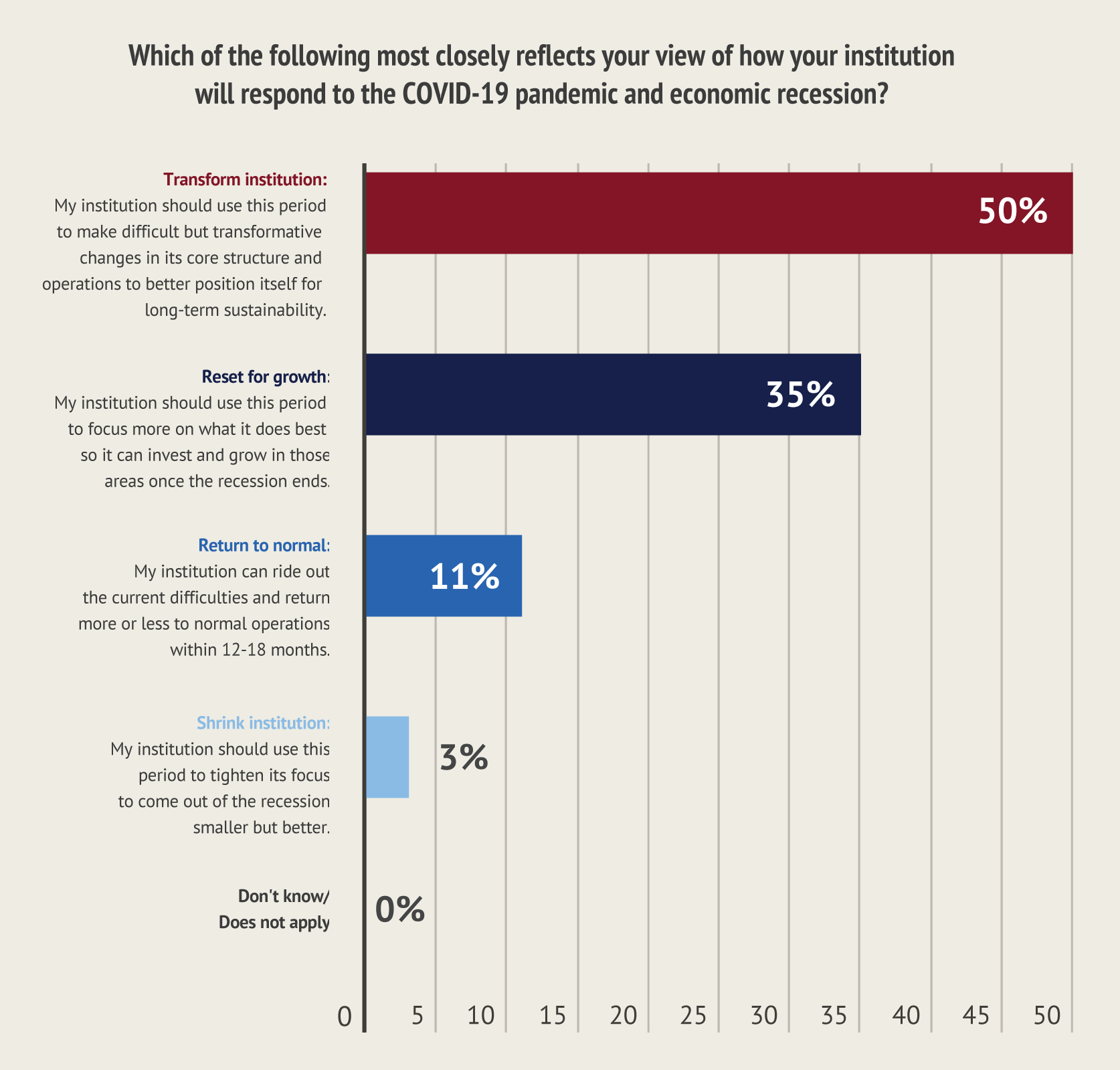
The survey offers some evidence of what that re-envisioning might look like.
Asked which of a series of potential revenue-generating or cost-cutting measures they might take in response to budgetary concerns in the coming months, seeking more federal or state support continued to top presidents’ lists. But fewer presidents in June than in April said they would try to cultivate new donor bases or start or expand capital campaigns, suggesting increasing recognition that they may struggle to tap traditional sources of revenue. A third said they would make "unscheduled or larger-than-planned draws" from their endowments. Only 12 percent said their institutions would reconsider their tenure policies, although 22 percent of private college leaders said that.
Meanwhile, eight in 10 said they would "reassess the long-term mix of in-person vs. virtual education we offer," and 55 percent (up from 41 percent in April) said they would reduce their academic program portfolio.
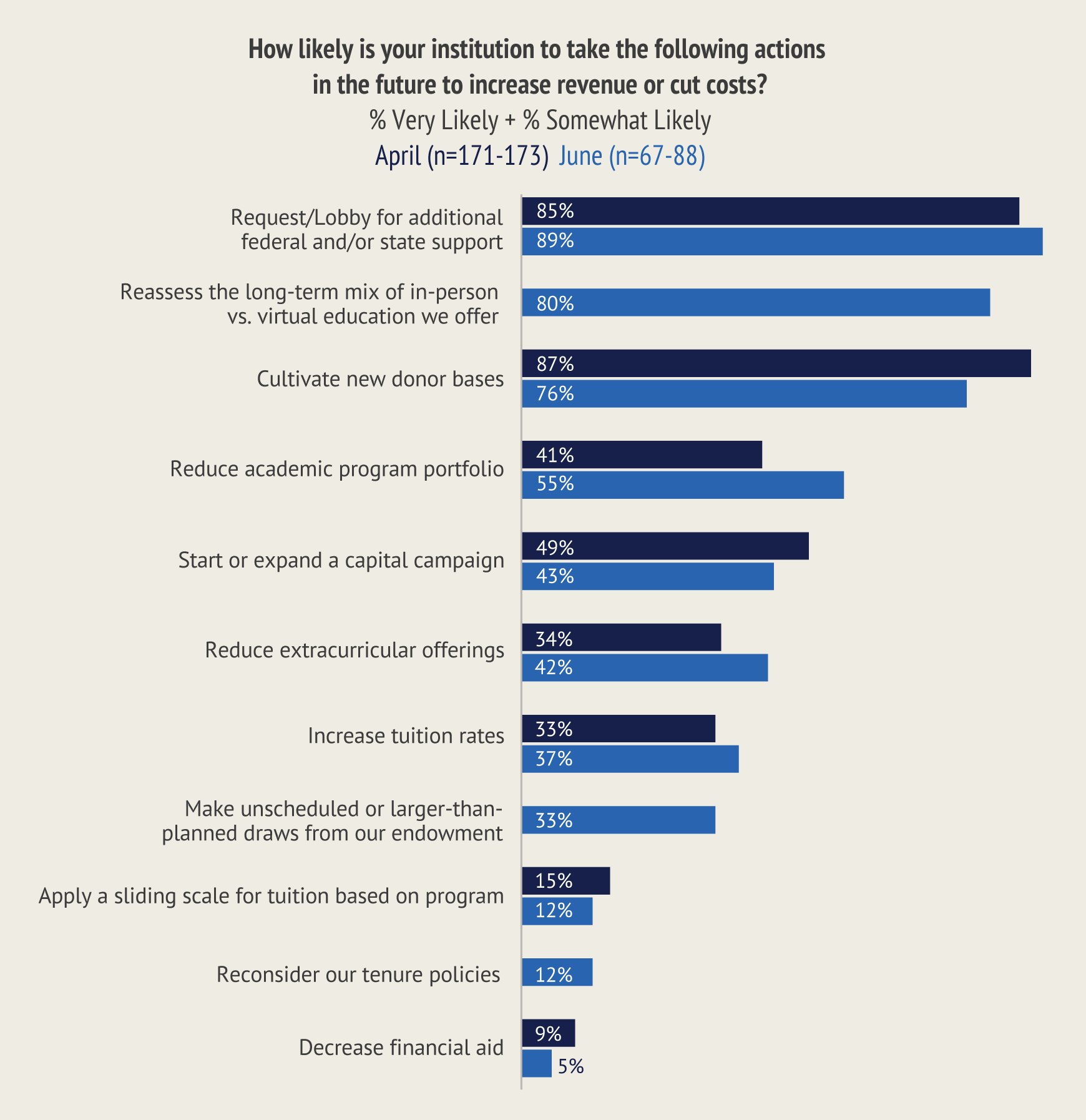
"It looks like institutions will be thinking of more fundamentally changing their cost structure through a permanent shift in how they deliver education," said Accenture’s Fisher, noting that nearly half of presidents said they would not reverse new investments they had made in online learning resources. "This contributes to mounting evidence that the COVID crisis may have spurred the shift to an era of pervasively hybrid education."
The Racial Environment
Inside Higher Ed’s previous surveys in March and April focused entirely on the pandemic and the recession, but since then the world has been shaken by another major development: the highly publicized deaths of several Black Americans and an explosion of protests about police violence and structural racism. We thought it was important to gauge presidents’ views on those topics, too.
The survey asked campus leaders which policies or structural changes they had embraced or were considering embracing in response to these concerns.
Half of or more presidents said they were implementing curricular changes (55 percent), mandating diversity training for employees (52 percent) or adopting new faculty and staff hiring goals (51 percent), while slightly fewer than half said they were changing student orientation or expanding recruitment into underserved communities.
About one in eight said they were taking none of the above steps, and about 20 percent cited other steps they were taking. Those write-in steps included creating diversity offices or hiring diversity officers or mandating that qualified minority candidates appear in every finalist pool (the so-called Rooney rule). One president said his four-year private institution was encouraging diversity training ("we won’t mandate it"), and the head of a four-year public university wrote, "My university is already diverse in student body and faculty."
The survey also asked presidents to assess the likelihood of protests about racial inequality on their campus this fall. More campus leaders thought such protests were unlikely (49 percent, 16 percent of them very unlikely) than likely (41 percent, 17 percent very likely).
Other Findings
The survey offered a range of other results. They include:
- Presidents remain deeply uncertain about whether or when their students and faculty and staff members will resume international travel, with between two-thirds and three-quarters saying they don’t know when their institutions will lift suspensions on those activities.
- Asked to cite operational areas where their institutions could use more support, financial health and operational planning was still the top choice, of 47 percent of presidents, followed by faculty training and development and instructional technology development. The only two areas that drew more interest from presidents since April were in marketing and communications and "strengthening brand perception."
